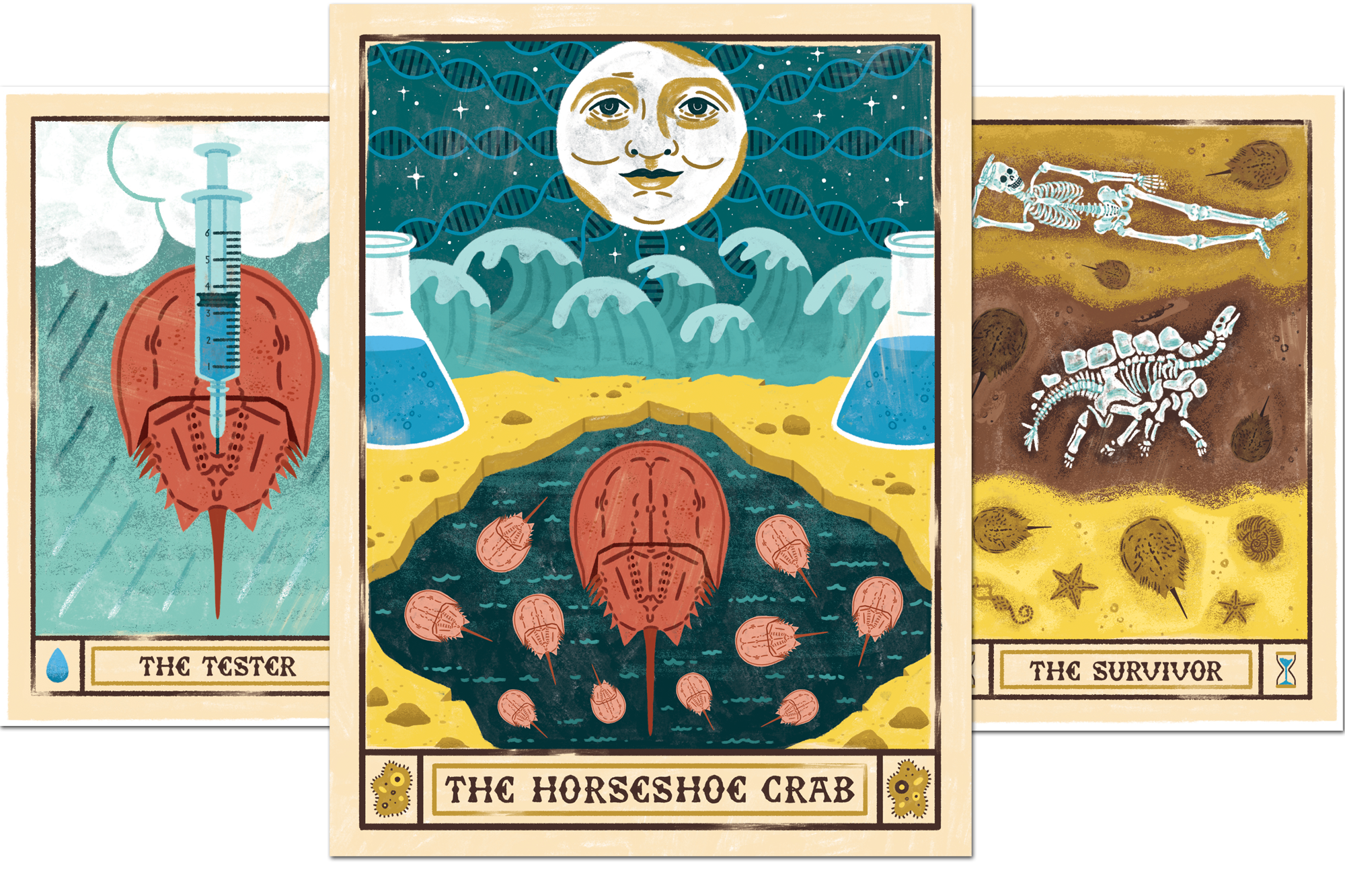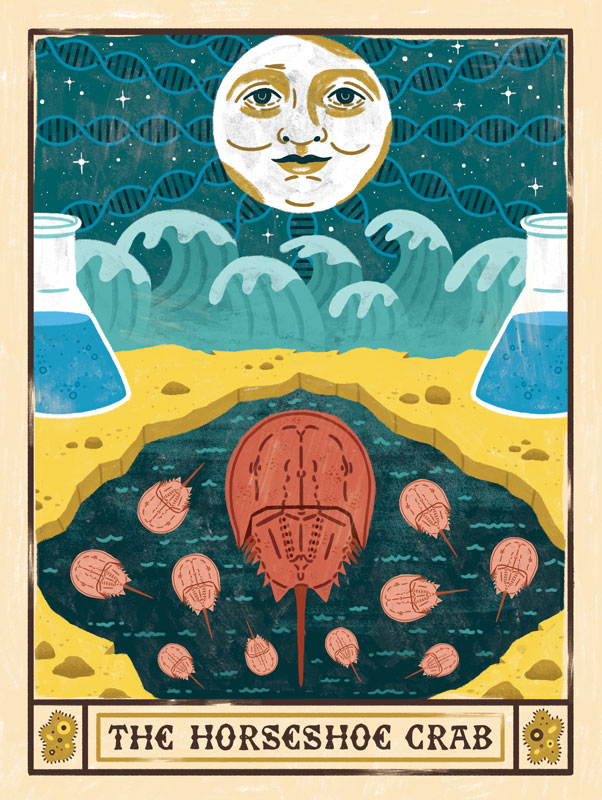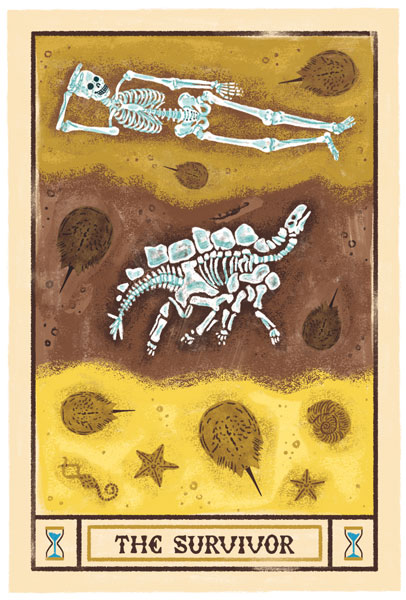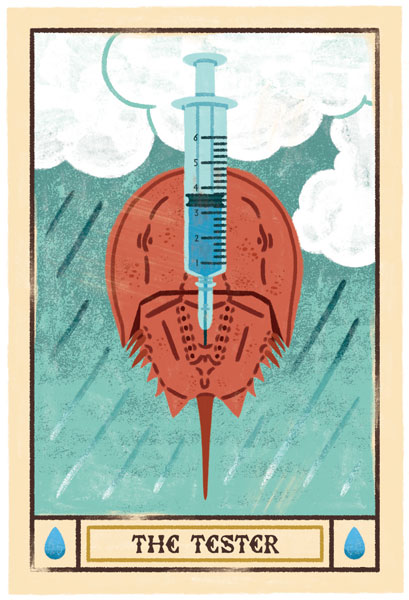
The Fortunate Ones?
Unique among species, the horseshoe crab has persisted, unchanged, for hundreds of millions of years. But now, its survival is threatened by the harvesting of its prized baby-blue blood. A team at UConn seeks to map its DNA and save it from extinction.
By Kim Krieger
Illustrations by Katie Carey
"What is that — it looks like a prehistoric Roomba," my friend said.
We were sitting on a seawall, our feet dangling in the water. "That" was weaving its way through the sea grass beneath our toes. Roundish and brown, about a foot and a half across, with a long, sharp tail, it was a horseshoe crab, patrolling the tidal realm for worms and shrimp and bits of detritus that it would promptly hoover up, eating and cleaning the seafloor as it went.
Horseshoe crabs are ubiquitous along the coast of Connecticut and the rest of the eastern U.S., but most people who live elsewhere, like my friend, have never heard of them. Which is odd, because most of us owe our lives to their blood.
Eons
Horseshoe crabs first evolved 450 million years ago, a little after the supercontinent Pangaea began breaking up. It was a time long before the dinosaurs, when mollusks and trilobites dominated the seas and the most complex life-forms on land were plants similar to liverworts.
Pause just a second there and think about that. There were no land animals. Not even insects. There were no trees, no ferns, no flowering plants.
But there were horseshoe crabs.

"The dinosaurs came and went, but the crabs stayed," says Rachel O'Neill, a geneticist and director of UConn's Institute for Systems Genomics. O'Neill is an expert in mapping the DNA of weird genomes. Most recently, she was part of the team that sequenced the koala genome, but she's also done salp (jellyfish-like creatures) and tammar wallaby (miniature kangaroo).
"Weird animals have weird biology and are great ways to understand species diversity and adaptation to Earth's diverse environments," O'Neill says. Now she's focusing closer to home to map the DNA of possibly the weirdest animal of all: the local Connecticut horseshoe crab, Limulus polyphemus.
One of the horseshoe crab's great mysteries — the thing that makes it weirder than almost anything else alive — is that it hasn't changed since the Ordovician period of the Paleozoic. That's close to an eon of geologic time.
The crabs cruising today's shores are absolutely identical to the crabs that crawled around post-Pangaean waters. The horseshoe crabs of the Ordovician already had ten legs, eyes on their tails, the rounded shell with a hinge a third of the way across that lets the crabs fold and maneuver and flip over. And they had the amazing blue blood so cherished by today's medical industry that it could threaten the well-being of the species. A map of the horseshoe crab's DNA would not only be a window into the DNA of the Paleozoic period, it could also be the key to the species' survival.
"One of the horseshoe crab's great mysteries is that it hasn't changed in close to an eon."
Bluebloods
Horseshoe crab blood is so valuable because it is teeming with cells called amoebocytes. Amoebocytes attack bacteria and coagulate like glue around them, instantly sealing off holes in the crab's circulatory system. Because even 450 million years ago, bacteria were everywhere. That violent reaction to bacteria has made horseshoe crab blood the perfect elixir for the pharmaceutical and medical device industries, which use an extract from the blood to test for contamination every batch of vaccine, saline, or other injected drug, as well as every pacemaker, artificial hip, or other implanted device.
Now you might think, why, what's the big deal? There are plenty of ways to make sure things are sterile; we've known how to do that since Louis Pasteur boiled milk in the 1800s.

But for injectable medications and implantable devices that come into contact with our bloodstream, sterility is not enough. Sterility means there are no live microorganisms that can cause infection. But sometimes organisms don't have to be alive to cause trouble. Mere pieces of the cell walls of gram-negative bacteria can cause the human body's immune system to freak out and become septic, a terrible cascading inflammatory disease that can kill quickly if unchecked. This was a serious problem in nineteenth and early twentieth century medicine, when traces of dead gram-negative bacteria on otherwise sterile equipment or medications killed many people. To prevent this, manufacturers kept large numbers of rabbits, injecting them with test samples and monitoring them for days to see if they got sick.
Until 1956 when, in a stroke of luck, physician researcher Frederik Bang realized that the cell walls of gram-negative bacteria are exactly what cause horseshoe crab amoebocytes to react. Test a sample of medicine with horseshoe crab blood extract, limulus amoebocyte lysate, and if the stuff clots you know immediately there is contamination. Fast and effective.
Today, the limulus amoebocyte lysate test is the FDA standard. But horseshoe crabs have to be captured from the wild and bled. More than 300,000 crabs are gathered, pierced near their hearts, and bled every year in the eastern U.S. The baby-blue blood gathered sells for about $60,000 per gallon, according to a September 2018 Business Insider report. The bled crabs are then released, but a research study showed 18% of them subsequently die, and the females do not breed for some time after being bled.
The fact that there is only one research study publicly available that even tracked horseshoe crabs after they were bled brings up another important point: There is very little research on them at all. In fact, when O'Neill's lab tried to raise baby horseshoe crabs from fertilized eggs, they found no instructions on how to do so.
Eventually they figured it out.
"The dinosaurs came and went,
but the crabs stayed."
Babies
"Look, I found a molt today," says graduate student Kate Castellano. Like many insects, horseshoe crabs shed their skin when they grow too big for it. Castellano holds up a thin, transparent shell, its diameter barely the length of the first joint of her thumb. It's from one of the little Limulus babies scooting around the 30-gallon tank in a common area of the Institute for Systems Genomics. The little crabs hop, using their tails to jump. They can also stand up on all 10 legs, legs that surround their mouths on their undersides.
Even in places where horseshoes are plentiful, few people get to see baby crabs. They stay safely in the water where they can't be spotted and eaten by land predators. But here, in the Institute's common area, there's a round table with four chairs. People often come and sit by the tank to watch.
Translucent beige with brown spots, the whole front end of the crab's carapace is covered in sensory cells that can smell. When Castellano drops shrimp in the tank, the crabs converge and eat like hungry hungry hippos in the children's game. There are 27 of them in the tank, which is decorated like the town of Bikini Bottom in the "SpongeBob" cartoon."A lot of what we're doing is pretty basic biology," says Castellano. In the beginning "we didn't know their lifespan." Around 30 years it turns out. But in raising the crabs and examining their DNA, Castellano and O'Neill have discovered a lot.
One of the larger babies grabs a particularly big piece of shrimp and falls onto its back, trying to wrestle the piece into its mouth on its underside. Perhaps babies isn't the right word; at almost three years old, they're more like toddlers. Horseshoe crabs mature at about the same rate as humans, becoming sexually mature between 12 and 15 years old. This means it's hard to do multigenerational studies of them in the lab. And it also means they would take a long time to bounce back from a population crash. Unfortunately their numbers are already dropping. In areas where crabs are most commonly harvested, fewer and fewer females are showing up to mate. Some places used to have so many crawling up the beach at the full moon in spring that the sand seemed to have turned entirely to crabs. That sight is rarer now, although the animals are still common along the Connecticut coast.
Synthetics
Capturing another creature and bleeding it on a yearly basis to provide for our safety may seem morally questionable. But no one wants to go back to maintaining rabbit colonies, either. Some researchers have recognized this, as well as the concern that soon there may not be enough horseshoe crabs to satisfy the yearly demand for blood. So there is now a company that makes a synthetic replacement for limulus amoebocyte lysate. The replacement works okay; it was recently approved by the European Union as an acceptable substitute. But it is based on a simple copy of a single protein in horseshoe crab blood.
O'Neill, Castellano, and their colleagues think they can do better than that. They are mapping a full assembly of the horseshoe crab's DNA. Part of their goal is to look for a more complete understanding of the amoebocyte response. They are striving to get every gene isolated and its function described, or at least hinted at.

It's not easy — there aren't many detailed DNA maps of modern spiders or ticks, the crab's closest living relatives, to compare to, much less any of a 450-million-year-old fossil. But O'Neill 's lab has already made its own horseshoe crab DNA assembly and is comparing it to the two other horseshoe crab genomes that have been published.
Compiling a complete map of an organism's DNA is like cutting up a dictionary into little pieces, shuffling them in a bag, and then putting it back together. Each word or gene might be sliced into two or more pieces. And unlike words in a dictionary, the genes don't have their definitions written out neatly next to them. Annotating a genome — describing the function and meaning of each gene — can take years and is rarely complete, simply because we don't yet know what a lot of genes do.
The two currently published horseshoe crab genomes are nowhere near as detailed as O'Neill's assembly, but whenever you cut up a dictionary into tiny pieces, some get lost. It's always good to compare with someone else's reconstruction to mop up any bits you've missed.
Reveals
What the UConn scientists have already found has been astonishing. First, the horseshoe crab has seven copies of its genetic code. Humans have two, one from mom and one from dad. Plus, none of those seven copies has a complete Hox gene set. Hox genes tell developing fetuses where to grow limbs and a head — essentially how to structure the body. Geneticists had thought that every animal needed one, but apparently the horseshoe crab manages without. And this might be a clue to one of its great secrets: "We hypothesize, maybe the horseshoe crab can't change. Maybe it's frozen, because it's missing a Hox cluster," O'Neill says.
The second astonishing thing is the genes that researchers suspect describe the action of the amoebocytes in the crabs' blood. O'Neill and her colleagues believe they might be able to understand the reaction well enough at the molecular level to design a synthetic test that is even more sensitive than the horseshoe crabs', or a non-liquid that can work as a swab on a surface. Such a synthetic could be the crab's salvation.
"Most of us owe our lives to
their blood."
"At this point it's science fiction. But this is a novel way of thinking about any contaminant detection," says O'Neill.
Science fiction or not, it's a compelling idea. In a twist of fate, horseshoe crabs and biotech companies seem to prefer the same real estate. How many of the pharmaceutical chemists, executives, and entrepreneurs working in Connecticut's rich biotech corridor along Long Island Sound realize that their ability to bring their products to market hinges on the health of prehistoric arthropods crawling through the tidal muck a few hundred yards away?
How ironic, and lovely, if they never have to think about it — if, someday soon, we can design a substitute for the horseshoe crab's amoebocytes that works even better than the original.

Leave a Reply